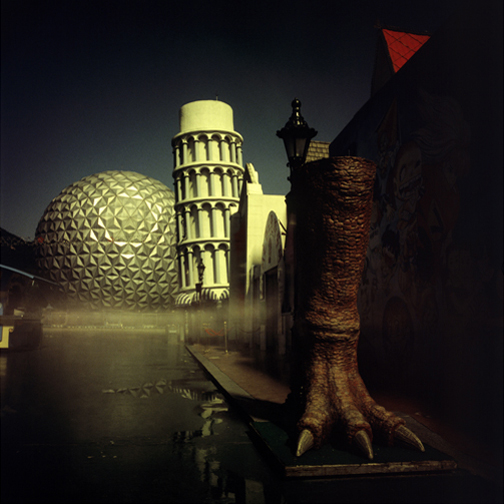
| To Alice... ..., 1994 |
| Retrograding Time |
| Kim, SeungGon, 1995 |
It is impossible to figure out why it occurs to one’s mind that his photographs are taken in the afternoon of late summer. It is because of their discolored tones found in a picture while sightseeing, or featureless objects wandering like the consciousness melted down in the heat of the burning sun. Those short-lived beings on the center of the dimmly lighted stage are slowly being faded out into deserted darkness. There’s a hole made on one side of reality and the other side of the world-that of dreams, the stage filled with laughters and the voices of children are now in the world of emptiness. The thing that we can find out there, is the time that makes our senses fall into slumber. Time that continuously retrogrades towards death. As we go through those unusual hours, we experience the feeling almost near to despair. Drawings can’t appear by chance. Drawings come into being through the process of time. But photography is finished the moment the shutter is pressed. A snap shot that picks up a moment of reality and unexpected haphazard is the essential nature of photography. The shorter the duration of the exposure is, there are more chances that it will depend upon haphazard. No matter how short the duration of exposure is and subtle the objects may be, there’s nothing which the camera can’t catch. Photographers have been creating their art by making use of those possibilities. Photography itself is just means to realize the creativity of the artist. Most of the photographs we have already seen are produced not through the nature of photography itself, but through the creativity of the photographers. But what will happen, if we exclude the haphazard and expose the constricted hours instead of instant and fragmental moments on photosensitive materials? Some artists are trying to identify the nature of photography by means of extending the duration of exposure and restraining the intensity of radiation. Park, HongChun is one of them.
|
The works shown in this article, all had long lasting durations of exposure of 30 minutes, which seem rather excessive. By the way, to those who understand the theory of optical science and the characteristics of photosensitive materials, there is nothing to be bewildered. Nevertheless, the power of his photographs to attract the soul of humanbeing lies in the fact that the world he pursues is deeply related with the concept of time. The objects that lost focus due to the continuous movement and shadow, make us experience some kind of impracticable time. His techniques of vagueness, that is by no means distinct or clear, gives us a chance to approach our inner world through the media called ‘The lasting of time and imagination.’ There is no question that, it is very different from the characters of photography we are accustomed to. But it is one of the best means to show the nature of photography. His photography is the world where every being extinct. On an afternoon, in a place like a zoo or an amusement park, human and animal hide themselves like ghosts in the dim light. This is a proof of existence for something that once came into being and at the same time, a proof of nonexistence for those disappeared. This is the reason why his time contains the whole-everything from the past to present. I am not sure why the memories of Louice Carrol float to the surface of my mind when I see a picture of ‘Alice in Wonderland.’ A ray of light which shines through a tiny pin-hole called consciousness soaks into the inner mind along with the flow of time. And that forms an uncertain figure. Yes! It’s because of his pictures have a charm which invokes our sweet memories of a girl. A girl is a mysterious illusion of the past that everyone cherishes. Optic illusion is a phenomenon that happens with the reproduction of the interposition of light. We can be sure as long as we look into his picture that he holds certain evidence on his mystic and spellbound rays of light.
Originally Published in The Monthly Photographic Art Magazine SaJinYeSul, Jan. 1995. Kim, SeungGon is a photography critic and the porfessor of photographic arts at Sunchon National University. He has been the jury president of Sajin Bipyong Awards since 1999.
|